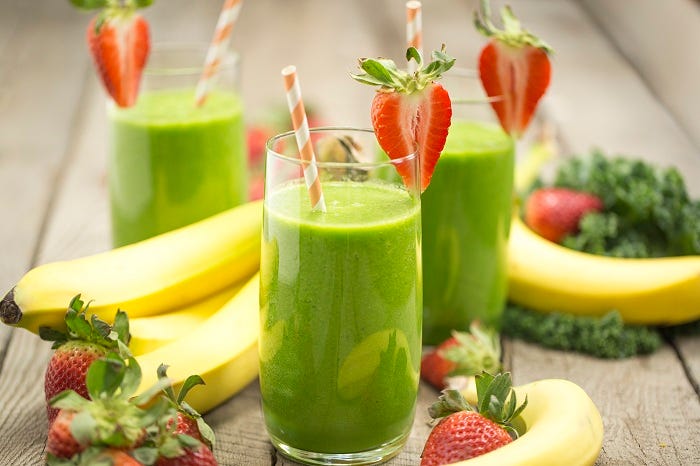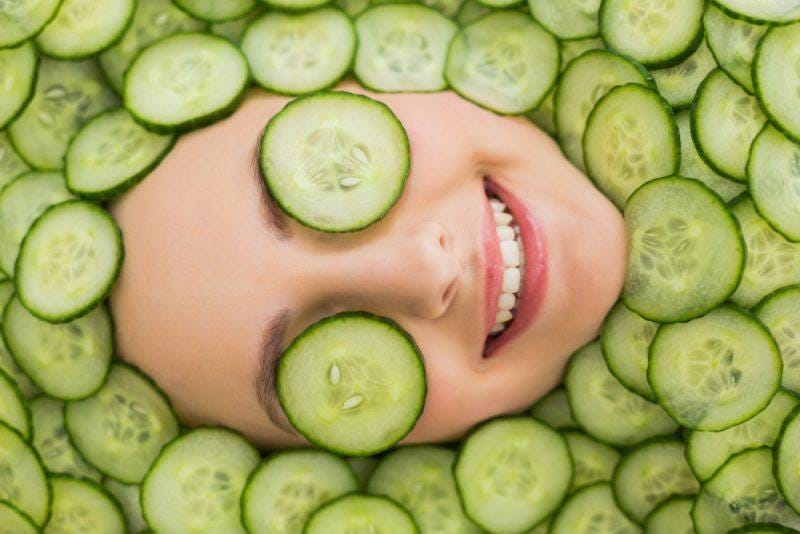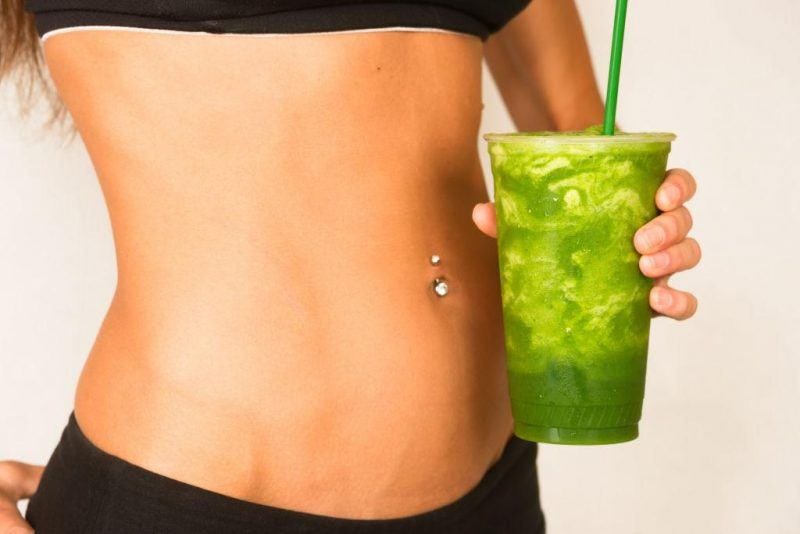Yes, green smoothies can taste better than they look
Click to read the full story: Yes, green smoothies can taste better than they look
Why Bother With Green Smoothies?
Yes, I know. Ugh, green smoothies? They’ve been around forever, but there’s a reason why. They can truly reinvigorate a tired and listless body. I know because I was there many years ago. I had let myself add an extra one-hundred pounds, and I was miserable.
Then I finally took a look in the mirror and realized how unhappy I was and then taking one step at a time, I slowly began eating better. Rather than rush into it and then stop, I took it slow and then finally got myself into juicing. I used to think it was too expensive and too much work, but after experimenting, I realized that many of these juices taste amazing. You can make the same type of thing you find at Jamba Juice for just a fraction of the price which is just another plus!
If you enjoy this guide, you can share it or also just download the PDF we made for you down below at the bottom of the article.
You see them everywhere these days, juice and smoothie bars and retail outlets going by names like Jamba Juice, Smoothie King and Tropical Smoothie Café. They sell blended fruit and vegetable drinks that are usually chilled, and could contain a wide variety of ingredients such as honey, syrup, sugar, milk or yogurt, low-fat cottage cheese and protein powders. These smoothie and juice joints exploded in popularity in the 1990s, though health food stores on the western coast in the US began selling smoothies way back in the 1930s.
That was when the electric blender debuted in the United States. Ice cream vendors and health stores began selling smoothies that usually added ice, dairy products and some type of sweetener to a fruit or fruits. Vegetables were sometimes used, but were not the primary ingredient. Right after retail smoothie and juice stores came into vogue at the end of the 20th century, green smoothies started to become very popular. They predominantly focus on leafy green vegetables such as kale, collard greens, celery and spinach, and are a great way to get your daily ration of healthy vegetables into your body.
When Australian businessman Joe Cross began preaching the health properties of juicing leafy green vegetables in 2005, the groundwork had already been laid for a juicing and smoothie explosion. Cross drank nothing but juices that were 80% vegetables and 20% fruit and ate nothing for 60 days. In that time, he lost 82 pounds and beat an autoimmune condition his doctors said he would have for the rest of his life.
He released a film of his juicing journey, titled Fat, Sick and Nearly Dead. He made the movie available free of charge online at his website, as well as video sharing sites like YouTube. Seemingly overnight, everyone was making juices with leafy green vegetables for health reasons, with some people reporting truly miraculous physical transformations. You can check out his book by clicking here. The link to his free film is just above.

The Health Benefits of Green Smoothies
The benefits of drinking green smoothies are numerous. The vegetables and fruits that give green smoothies their fresh, emerald hue are extremely high in nutrients, minerals, vitamins and antioxidants. They provide a long list of benefits and can improve both your mental and physical health. Kale is a popular leafy green in smoothies that offers the following health advantages.
High in fiber, low in calories and has zero fat – Kale delivers up only 36 calories in a 1 cup serving. That serving size also packs a healthy 5 grams of dietary fiber and zero fat.
Helps digestion and elimination – The fiber in kale promotes healthy digestion and helps keep you “regular.”
Absolutely packed with vitamins and nutrients – Kale delivers significant amounts of magnesium, folate, iron, vitamins A, C and K, and delivers more calcium than milk per calorie.
Fights cancer – The antioxidants, carotenoids and flavonoids present in high levels in kale help protect you against developing various cancers.
Boosts bone health – Eating kale (or drinking a smoothie with kale in it) delivers the vitamin K mentioned earlier. Vitamin K is essential for optimal bone health, as well as blood clotting.
Fights inflammation – This versatile and powerful health booster boasts excellent anti-inflammatory properties. Inflammation is often the starting point for multiple chronic diseases and illnesses.

Improved brain function – A diet rich in kale has been linked to better memory and a lowered risk of developing neurological disorders like Parkinson’s disease and Alzheimer’s.
A wonderful detoxing agent – Kale helps your liver filter out dangerous toxins and poisons, removing them from the foods you eat and the liquids you drink, so they can be eliminated.
Boosts healthy circulation – The iron in kale ensures that high levels of oxygen are transported to the various parts of your body that need it.
All of the healthy nutrients and minerals in kale also boost your overall immune system, help your cells grow properly, assist in the formation of enzymes and hemoglobin, lower your cholesterol, and fight asthma, arthritis and autoimmune disorders.
Look at those amazing rewards for getting kale into your body.
Now imagine how supercharged your health and vitality is when you combine that leafy green with other healthy vitamins and fruits commonly used to make a green smoothie. You can literally handpick your smoothie ingredients to provide any type of health boost you need, from stronger, shinier hair and younger looking skin, to improved memory, no joint pain and total heart health.
Later on in this article, we will reveal the best vegetables to use in your green smoothie. We will also list the health properties each of those vegetables provide, so you can cater your green smoothie experience to deliver exactly the healthy rewards you are looking for. Right now though, let’s take a look at the reasons for choosing predominantly green vegetables over fruits the next time you make a smoothie.
So Why Choose Smoothies with Greens Over Fruits?
There is absolutely nothing wrong with putting fruits in your smoothies. The average person these days doesn’t get enough vegetables and fruits in their diet. Any time you choose fresh produce over processed food, junk food, sugar, salt, refined flour and other unhealthy food items and ingredients, you are doing yourself and your health a huge favor.
Sometimes though, people report weight gain after they start to drink lots of smoothies that are predominantly fruit-based. This happens for a very logical reason. If someone is trying to impact their health in a positive way by adding lots of healthy fruit to their smoothies, they have to be careful about their calorie and carbohydrate intake.
Vegetables have much fewer calories and carbohydrates per ounce than fruit does. If you choose predominantly fruits instead of vegetables for your smoothies, there is a possibility of weight gain because of this reason. Many fruits also have levels of natural sugar that are much, much higher than the typical vegetable. Most vegetables have little to no natural sugar.
You probably know what happens when the human body takes on too much sugar. It gets fat. So one very good reason to choose smoothies with mostly leafy greens over smoothies with too many fruits in them is to keep from gaining weight. A lot of people adopt a “1 smoothie a day” policy for the purpose of losing weight, they eat too many fruits, and they wind up gaining weight instead.
You may be wondering, “If green vegetables are so healthy, why can’t I just eat them instead of putting them in my smoothie?” That is a great question, so let’s answer that right now.
Is Drinking Green Smoothies Better Than Eating All Those Greens?
Joe Cross has a smoothie recipe called Joe’s Mean Green Smoothie. It contains the following ingredients.
1 cucumber
4 celery stalks
2 apples
6-8 leaves kale
1/2 lemon
1 tbsp. ginger
1 banana, frozen
1 cup (250 ml) almond milk
When was the last time you ate an entire cucumber, 4 stalks of celery, 2 whole green apples, a large bowl of kale leaves, a half of a lemon and a banana? Those ingredients combined with a cup of almond milk to make just 1 smoothie! If you drink 2 or 3 smoothies a day, double or triple that list of produce.
This brings up why it is so much smarter to drink green smoothies than trying to eat all those vegetables and fruits instead… you simply cannot eat, digest and consume the number of fruits and vegetables that go into making 1 or more smoothies on a regular basis.
Those foods, like the kale we mentioned earlier, that go into your smoothies are packed with nutrition. They are virtually bursting at the seams with health and well-being. Since it is very difficult, or impossible, to eat the same number of healthy fruits and vegetables that make up a green smoothie on a day-to-day basis, choosing a refreshing, chilled smoothie is the perfect vehicle for receiving all the health benefits those foods offer.
There is another very good reason to choose drinking your greens rather than eating them.
When you render healthy fruits and vegetables into liquid form, your digestive process is very quick. Because of the high amounts of densely packed fiber in physical fruits and vegetables, it takes a while for your body to digest them properly. When you add the ingredients of your smoothie into your blender, that blender is acting as a digestive aid. It is breaking down those foods for you, so access to the minerals, nutrients, vitamins and other healthy components in your fruits and vegetables are absorbed by your body much quicker.
This is why you can often times feel a surge of vitality and healthy energy only minutes after drinking a green smoothie. Your body begins to assimilate all of the health-boosting properties of your smoothie ingredients immediately. Finally, another reason to juice your greens rather than eating them is to save time. When you are in a rush, you can make a healthy smoothie and literally a couple of minutes. That beats the prep time eating time and cleanup time that can sometimes be extensive when you are cooking your greens rather than using them to make a smoothie.
The Basic Green Smoothie Formula
Ask 10 different people, and you may get 10 different responses to the following question. “What is the definition of a smoothie?” Health gurus and other smoothie enthusiasts are not any clearer on exactly what is required for a beverage to be called a smoothie. Some say for the smoothie label; a drink has to have ice and milk. Others replace milk with low-fat yogurt or some other dairy product. Still, others opt out of milk entirely and use water as a liquid base.
Generally speaking, a smoothie is much thicker and has a much heavier consistency than if you were to make a fresh juice. Smoothies are usually made in a blender and not a juicer, and will be chilled most of the time. The consistency is that of a thick milkshake. However, a milkshake requires ice cream, which you will not find in a healthy smoothie.
If you check a dictionary, you will find that a smoothie is defined as “A person who has a winningly polished manner.” The second definition found at Dictionary.com is more of what we are looking for, “A thick beverage of fruit puréed in a blender with ice and milk, yogurt or juice.” If you stick to that definition, you see that the actual ingredients of a smoothie are up to you.
In almost every case, smoothies are made with fruits and vegetables as a healthy beverage, and not things like refined sugar and ice cream, which would constitute an unhealthy desert drink.
Just remember what was mentioned earlier. If you stick to mostly fruits in your green smoothies, you may find it difficult to lose weight, and you may even gain weight. Replacing most of the fruits with healthy leafy greens and the occasional green fruit is what makes green smoothies so powerfully healthy.

Focus on at least 60% or 75% vegetables in your green smoothie recipes. This will provide a lot of healthy nutrients and minerals, without putting too many calories, carbs, and too much natural sugar into your body.
If you need help getting started, check out this basic green smoothie formula.
1 to 2 cups of liquid
2 tablespoons of binder
1 or 2 handfuls of frozen fruit
4 to 6 ice cubes
2 – 4 tablespoons of protein powder
1 soft fruit
Green vegetables like kale, spinach, celery, arugula, collard greens and cabbage, bok choy and beet greens, chard and dandelion greens, to name a few.
Healthy sweeteners and oils are optional.
Expect 2 to 3 smoothies of 16 ounces each with the above basic recipe.
Your liquid could be milk, nondairy milk like almond milk, green tea or water. Binder is anything that gives your smoothie a thicker consistency and holds it together, like ground flaxseed, nut butter or raw almonds. Protein powders are available with peas, hemp, sprouted brown rice or a blend of all 3 as the protein base. Bananas or avocados qualify as a soft fruit.
It is also up to you whether you want to include any “superfoods.” Adding cacao nibs, powdered greens, ground cayenne pepper, pumpkin or chia seeds, cauliflower, ground whole oat bran, baobab, green apples, coconut oil and walnuts can really ratchet up the health-boosting nutrients and minerals you get from your green smoothie.
As promised earlier, now we will take a look at the best greens to add to your smoothie. These are those fruits and vegetables which deliver significant health benefits because of the vitamins and minerals they contain.
Top 14 Green to Include in Your Smoothie
We discussed the incredible health properties of kale earlier. The following green fruits and veggies also have the ability to deliver certain physical and mental benefits. Listed alongside each piece of produce are a few of the known health advantages of eating that particular food. Simply pick and choose from the list below to see positive change in many areas of your life.
For example, start making green smoothies with Swiss chard to lower a high blood sugar level. Spinach in your smoothies leads to healthy, glowing skin and naturally high levels of energy. Bok choy promotes bone strength and heart health. Green smoothie drinkers report the most all-around health improvements by continually changing the types of green veggies and fruits they blend.
1 – Swiss chard – As just mentioned, Swiss chard is great for maintaining healthy blood sugar levels. It is full of vitamins A, C and K, as well as magnesium, potassium, iron and manganese. Aside from helping you manage your blood sugar, Swiss chard promotes overall heart and cardiovascular health, improves bone density and helps your lungs work properly.
2 – Bok choy – As we said above, bok choy promotes bone strength and heart health. It is full of vitamins A, C and K, and folate and calcium. This means that while it is good for your heart, bok choy also helps your bones grow strong.
3 – Spinach – If you are familiar with the cartoon character Popeye, you will know that spinach can make you strong. That is because one single leaf of spinach delivers more than 20 different nutrients! We said earlier that spinach is good for creating strong, healthy, young looking skin and high energy levels.
Spinach also naturally fights cancer, improves your vision, boosts heart health and your immune system, acts as an anti-inflammatory agent and helps lower high blood pressure.
4 – Beet greens – When you buy beets, make sure they have their greens attached. Don’t just eat the beet root. The long, leafy stocks that grow above ground and which form the greens part of the beet support healthy blood, skin, vision and bones. This is partly because of the vitamins A, C and K beet greens contain, as well as essential minerals copper, calcium, iron, magnesium and manganese.
5 – Romaine lettuce – Romaine lettuce is easier on the taste buds than kale and Swiss chard. Although it doesn’t look as deep green as some other greens, it is full of large amounts of calcium, magnesium and manganese, as well as vitamins A and K, and the B complex vitamins. You will also find copper, phosphorous, potassium and zinc in romaine lettuce. From your heart to your skin, your circulation to your digestion, romaine lettuce provides plenty of health benefits.
6 – Arugula – Rich in cancer-fighting antioxidants, vitamins A, C, K and the B complex, and chlorophyll, arugula gives your immune system a boost. It also helps your brain function properly and strengthens your bones.
7 – Carrot tops – Don’t throw away the greens that are attached to the top of your carrots. Rich in magnesium and chlorophyll, calcium and potassium as well as vitamin K, carrot greens keep your muscles and bones healthy.
8 – Collard greens – Related to kale, broccoli and cabbage, collard greens are what is known as a cruciferous vegetable. They are excellent for cleaning out your system and promoting good digestion, which helps you regulate a healthy body weight. The vitamins A, C and K found in many healthy green fruits and vegetables are present here, as well as other vitamins, essential minerals and antioxidants.
9 – Dandelion greens – Did you know that every part of the dandelion plant, from its roots to its flower, is edible? Dandelion greens are more bitter than even kale, so a little bit goes a long way for flavor. These greens are one of the best sources of calcium and iron in the green plant kingdom.
They detox and cleanse your liver, have excellent anti-inflammatory properties and promote lung, heart and vision health. These super greens also make a complete protein, are full of calcium and iron, as well as vitamins A and C.
10 – Parsley – The frequently mentioned vitamins A, C and K are here, as well as calcium, folate and iron. There are plenty of health-boosting flavonoids and antioxidants as well, which help neutralize dangerous carcinogens while preventing oxidation damage in your cells.
Parsley also kills free radicals that do damage throughout your body, protecting you against conditions like colon cancer, diabetes and asthma.
11 – Broccoli – What’s that you say, you never would have thought about making a smoothie with broccoli? Start adding broccoli to your green smoothies tomorrow, because this cruciferous vegetable is considered a true superfood. It prevents and treats diabetes symptoms, protects against multiple cancers, has high levels of vitamins C and K, and like most of the greens on this list helps promote healthy digestion while regulating your body weight.
12 – Avocado – This green is technically a fruit and not a vegetable. Like broccoli, it is regarded as a superfood in nutrition circles. Avocados are full of essential fats that your body needs to promote healthy functioning throughout and deliver anywhere from 20% to 42% of 9 minerals, nutrients and vitamins your body craves in just a 1 cup serving.
They are loaded with dietary fiber to keep your digestive tract working properly, have more potassium than bananas, can lower high cholesterol and triglyceride levels, and they strengthen your heart. Also called an alligator pear, the humble avocado reduces blood pressure and protects against heart attack, stroke and kidney failure. Avocado fights inflammation and cancer, metabolic syndrome and belly fat, and the unique fat in avocados helps your body absorb more nutrients from other plant foods that you eat.
13 – Cucumbers – Very low in carbs but high in nutrition, the minerals and nutrients in a cucumber protect against inflammation throughout your body. They lower your risk of developing cancer and protect your brain health. Cucumbers are 90% to 95% water, so they help hydrate and cool your body.
14 – Celery – Approximately 2/3 of the fiber in celery is not digestible. This means celery can help you lose weight and maintain a healthy body weight while keeping your digestive system healthy. Celery has been linked to cancer prevention and has high levels of vitamin K, and also fights inflammation.
Celery is rich in antioxidants and enzymes that your body craves, in addition to vitamin C, potassium, folate and vitamin B6. Celery is heart healthy and has antioxidants and phytonutrients that promote a healthy liver, skin, eyes and cognitive abilities.
How to Make Smoothies an Easy Part of Your Routine
By now you are probably excited about the health-boosting possibilities of smoothies. You also probably have a busy life. You may find it difficult to squeeze smoothie-making time into your already hectic schedule. Don’t worry. The following tips and hacks will help you fit delicious and nutritious smoothies into your daily routine, so you don’t miss out on all the health rewards they deliver.
Make several smoothies at a time. Preparing 48 or 64 or more ounces of smoothies once and then storing in your refrigerator or freezer in individual containers makes for time-saving “grab and go” health.
A 32-ounce smoothie makes a filling, healthy full meal replacement.
When buying a blender, make sure the jar is easy to clean. Ensuring that your blender jar is dishwasher safe makes cleanup easy.
Plan one day each week for shopping for produce. When you get back home, dice, slice and chop your produce into small, blender-friendly pieces and store in separate transparent containers so you can tell what vegetables and fruits are what with a quick glance.
Make 32 ounces of smoothies for a couple of snacks during the day. At mid-morning and mid-afternoon, when you are tempted to reach for a sugary sweet for an energy boost, drink a 16-ounce smoothie instead.
Get the family involved. When everyone in your home begins seeing the health benefits green smoothies provide, they will want to make them a part of your daily routine.
Add some type of protein powder to your smoothies. This ensures you have plenty of protein-packed energy each day since some vegetables and fruits don’t provide high levels of protein.
Swap your morning coffee for a smoothie.
Do your prep work the night before. While making dinner, why not chop, peel and dice your fruits and veggies and place them in the fridge for the next morning or the following day?

8 Common Green Smoothie Mistakes to Avoid
There are mistakes you can make when undertaking any health plan. Avoid the following 8 commonly made green smoothie mistakes and your blended path to health and well-being will provide the most benefits and the fewest headaches.
1 – Using too many fruits. Remember, using too many fruits and not enough green vegetables could lead to unhealthy weight gain.
2 – Giving up after a few failed tries. If you make a green smoothie and it doesn’t taste good that is no need to stop making smoothies. You can always add your favorite fruits and vegetables to any smoothie to please your taste buds.
3 – Not adding water to your blender first. To keep from overworking your blender motor, you should add your liquids first, along with a few smoothie ingredients.
4 – Using the same greens every day. We mentioned earlier that changing up your green smoothie ingredients is important for overall health. Even if you find you have a couple of recipes you really enjoy, you need to discover other recipes that get healthy greens into your body on a regular basis.
5 – Not buying organic whenever you can. Purchase organic produce if at all possible. This food is as clean as it can be, and usually enjoys a much shorter time from the farm to your grocery store.
6 – Not washing your produce. Just 1 tablespoon of white vinegar per 1 gallon of room temperature water makes an excellent produce rinse. Let your produce soak for 10 minutes before aggressively rinsing.
7 – Using unhealthy protein powders. Protein powders are a common green smoothie ingredient. Make sure you are reading your food labels, and use only healthy powders.
8 – Letting the color turn you off. Some green smoothies will be extremely dark green and brown in color. Don’t let an unattractive looking color keep you from benefiting from these wonderfully healthy beverages.
Meeting Your Health & Fitness Goals with Green Smoothies
If you want to build strong muscles, incorporate protein-rich greens like spinach, kale and broccoli in your green smoothie recipes. For an overall health boost, cycle through all of the healthy greens listed earlier regularly. This will power your immune system and deliver a multitude of health benefits from head to toe.
If weight loss is your goal, make sure you are using 70% to 80% vegetables in your smoothie recipes.
This means more high-fiber, low-calorie produce that keeps your digestive system working properly, and fewer fruits high in sugar. You should also try to limit the amount of sweeteners and milk you use in your green smoothie recipes if you are trying to lose weight, or regulate a healthy body weight.
No matter what your fitness goals, try to drink at least 32 ounces of green smoothies each and every day. You can drink them in place of breakfast, or spread them out throughout the day. Doing so helps keep you full and getting your body used to the ingredients in green smoothies will begin to curb your cravings for unhealthy foods.
Consider replacing 1 or 2 meals with green smoothies every day. This does a couple of things for your health goals. It gets your taste buds and internal systems used to drinking healthy, green smoothies. It also keeps plenty of dietary fiber moving through your system so that you feel full, limiting the overall number of calories and carbohydrates you eat throughout the day.
This helps you burn fat and calories because you are limiting your intake of sugar, bread and other foods known to cause unhealthy weight gain. The nutrients, vitamins and minerals in your green smoothies simultaneously build strong muscles while limiting the intake of the foods that may have caused your health problems in the first place.
[pdf-embedder url=”https://movietvtechgeeks.com/wp-content/uploads/2017/05/Green-Smoothies-Can-Taste-Better-than-they-Look.pdf” title=”Green Smoothies Can Taste Better than they Look”]
If you enjoyed this and found it helpful, you can download it in PDF form right here. Enjoy and keep watching for more of our Health and Fitness tips to fit any lifestyle
The post Yes, green smoothies can taste better than they look appeared first on Movie TV Tech Geeks News By: Jackie Warner


